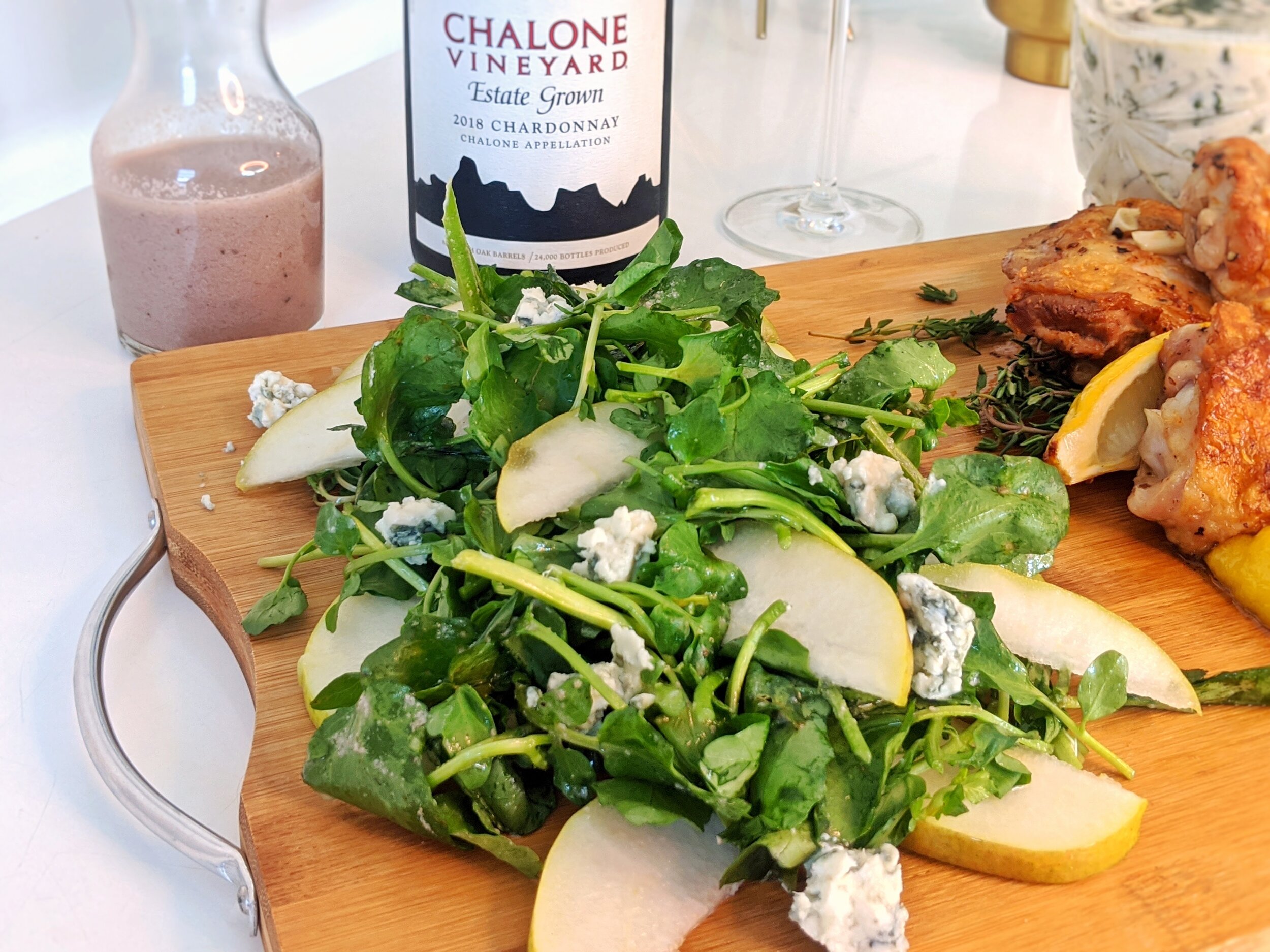How to Pair Wine Like a Sommelier
The Estate Grown Chardonnay and Pinot Noir are iconic California wines from Chalone Vineyards.
Food and wine pairing: it's an art and an (imperfect) science.
It's not a secret that sommeliers are obsessed with finding the perfect wine pairings-- after all, it's our job. As much as blind tasting and learning producers and vintages are part of the gig, our primary goal is making your experience unforgettable when you visit our restaurants. Creating a food and wine pairing that's so mind-blowingly good you'll remember it forever is the best way to do that, and that's what every somm strives for.
If you're not dining out much these days, the good news is: you can create incredible, mouthwatering at home pairings once you learn a few wine pairing strategies. I’m happy to share one of my go-to wine pairing methods, with a little help from my friends at Chalone Vineyards! Read on to see how it’s done.
What Makes a Great Pairing?
All wine pairing methods hinge on the same goal: achieving 'the third taste.' This is when food and wine come together to create a whole other taste sensation that's even more spectacular than they are on their own. They bring out the best qualities in each other (there's a dating metaphor in here somewhere...). Sometimes the flavors and textures are just fine as a food and wine pairing, but there are no real fireworks; sometimes, they even fight each. We always look for balance (neither food nor wine should overpower the other in weight or intensity), and hopefully, a little magic.
How to Create a Successful Pairing
There are so many ways to pair food and wine that whole books have been written on it. There are classic pairings, fancy pairings, regional pairings, high/low pairings, and honestly, pairings that should just never happen (I'm looking at you, wine and Girl Scout cookies!). But at the heart of it, I like to rely on two basic strategies: contrast pairing and harmony pairing.
Contrast pairing is when opposites attract: peanut butter and jelly is a great example. Something salty and something sweet- they balance each other out. On the other hand, harmony pairing happens when there are similar flavors in the wine and the food, enhancing each other. I think harmony pairings are the easiest, most basic pairings to achieve-- so they're the perfect place to start. Let's see them in action!
Putting Your Pairing Skills to Work: Start with Classics
Whenever you're trying to master a new skill, you should always start with the classics. So to demonstrate harmony pairing in action, I picked two wines that are not only classic varieties-- Chardonnay and Pinot Noir-- but also from a classic producer: Chalone Vineyards. Located in Monterey County, their legendary property is known for its limestone and decomposed granite soils ideal for making their Burgundian-style wines! I also love the history of the vineyard: it's the oldest producing vineyard in Monterey (it was actually planted by a pioneer from Burgundy, Charles Tamm, in 1919), and in the 1960s, was acquired by Richard Graff, who was one of the first to import French oak barrels and introduce Burgundian winemaking techniques to California. Chalone Vineyards was part of the famous Judgement of Paris wine competition in 1976 (a showdown between California and France where California actually won!)-- their 1974 Chardonnay came in third place.
When I found out there's a classic culinary connection-- Graff teamed up with Julia Child and Robert Mondavi to found The American Institute of Wine and Food-- I knew these were perfect wines to use for a wine pairing demo! In the classics' spirit, I adapted some classic Julia Child recipes to make them modern and fun, and show you how I approach a harmony pairing.
Pairing #1: 2018 Chalone Vineyard Estate Chardonnay, Chalone AVA Paired with Tarragon Chicken and Watercress Salad
Chicken thighs with a lemon tarragon cream sauce and a watercress salad are great pairings for Chalone Vineyards Chardonnay
The first step to deciding on my pairing here was picking out flavor notes in the wine, and seeing how I could incorporate some ingredients into a dish that would enhance those flavors. For me, this medium-bodied wine opened with a bright lemon note, followed by a ripe orchard fruit wave that was echoed with a light creaminess, a touch of toast, and all wrapped up in a clean mineral finish. I knew right away I wanted to incorporate lemon, pear, and cream into my dish and that I could choose a protein with a light to medium intensity (nothing that would overpower the wine).
Using my Julia Child inspiration, I found a classic Julia recipe for a whole roast chicken with butter and tarragon. I usually find whole roast chickens to be ‘project cooking’ to occupy a whole weekend afternoon; so I settled on a one-pan dish that can be made start to finish in 20 minutes: roasted chicken thighs.
To make them, pat your chicken thighs dry and season with salt and pepper, heat 1 T of olive oil on the stovetop in an oven-safe pan, then sear them skin side down until crispy (8-10 minutes.) Then flip them, add some crushed garlic, lemon slices, and thyme to the pan, and then roast uncovered in a 425-degree oven until a meat thermometer reads 165 degrees-- about 15 minutes.
One-pan chicken thighs are an easy and delicious weeknight alternative to roasting a whole chicken.
Instead of stuffing the cavity of a whole chicken with tarragon, I made a tarragon lemon cream sauce to serve alongside the thighs:
Tarragon Lemon Cream Sauce
Heat 2 T of butter in a small saucepan
Add 1 chopped shallot and saute until translucent (2-3 minutes)
Add 1 C white wine, and simmer until reduced by one fourth
Add ½ C light cream and heat until slightly thickened
Add any chicken drippings from the bottom of the roasting pan.
Remove from heat and add the juice of one lemon and a1 C roughly chopped tarragon
Season with salt and pepper to taste
To accompany the chicken, I made a spin on Julia Child’s watercress salad with walnut dressing. I added freshly sliced pear to bring in the orchard fruit element in the wine, and then added a touch of California: some Point Reyes blue cheese.
Walnut vinaigrette and Point Reyes blue cheese elevate a simple chicken dinner when paired with Chalone Vineyards Chardonnay
Creamy Walnut Vinaigrette
In food processor, blend:
1 tsp dijon mustard
3 Tbsp walnuts
3 Tbsp white wine vinegar
Drizzle in ½ walnut oil and process until smooth and creamy, Process with salt and pepper to taste.
Why this Chardonnay pairing works:
The chicken is a match in intensity with a medium-bodied wine. There’s also enough acid in the wine to balance out the richness in dark-meat chicken and keep your palate refreshed. I incorporated the harmony pairing strategy by mirroring some of the flavors of the wine in the dish: the lemon and cream in the sauce, the pear and nuttiness in the salad, which brings in a natural harmony to your palate. Finally, I employed a third pairing method: regional pairing! ‘What grows together, goes together’. The Point Reyes blue cheese in the salad the fresh herbs in the sauce bring a California feel to the dish that matches well with the Monterey-grown wine.
Creamy lemon tarragon sauce is heavenly with crispy chicken thighs
Chalone Vineyards Estate Grown Chardonnay is a sommelier favorite
Sommelier Sarah Tracey wine pairing tips
Pairing #2: 2018 Chalone Vineyard Estate Pinot Noir, Chalone AVA Paired with Duck Breast Pizza with Balsamic Cherries and Arugula
A breezy California take on seared duck breast: duck pizza!
The Chalone 2018 Pinot Noir is a relatively powerful style Pinot Noir with lots of dark fruits- black cherry and plum-- as well as some toasty spice and an earthy finish. I thought this would be fitting paired with a medium-plus intensity protein, and duck fit the bill (it’s a classic pairing for Pinot Noir). I found a Julia Child recipe for Muscovy Duck Breast with Chinese Spices, and I thought I’d reinterpret this in pizza form to make it more fresh and California-casual.
I followed Julia’s instructions for the duck breast:
‘Keep skin on the duck breasts, but trim any excess or fat. With a sharp knife, score skin of breast in a 3/8-inch crosshatch pattern. Season breasts with salt, pepper, and a pinch of Chinese five spice powder, pressing seasonings onto the skin. Pour oil into sauté pan, and when hot, add breasts skin side down. Sauté over high heat for 5 minutes until skin is lightly browned. Turn and cook 5 minutes more, until meat is medium rare. Let breasts rest 10 minutes before slicing.’
Chinese 5-spice duck breast, inspired by Julia Child
To turn it into a pizza, I sliced the duck breast into bite-sized pieces, and made a quick hoisin-based sauce:
Duck Pizza Sauce
In a small saucepan, heat until thickened:
4 tablespoons water
2 tablespoon soy sauce
2 teaspoon hoisin sauce
4 teaspoons rice wine vinegar
2 teaspoon honey
pinch of salt
pinch of Chinese 5 spice powder
All the components you need for a duck pizza recipe!
To assemble your pizza, use your favorite pizza dough (homemade or store bought), roll it out on a sheet pan, brush with sauce, and top with the duck breast slices and 8 oz of mozzarella cheese. To nod to the dark cherry flavors in the wine, I soaked some dried cherries in balsamic vinegar and dotted them over the top of the pizza.
Bake in a 450 degree oven until crust is golden brown and cheese is melty (12-18 minutes depending on the size of your pie). Top pizza with fresh arugula tossed in olive oil right before serving.
Why this Pinot Noir pairing works:
The wine has the concentration to be a perfect intensity match with the duck breast. The light spice qualities of the wine are complemented by the 5-spice seasoning in the duck sauce, and the dark cherries on the pizza are a harmony pairing with the cherry notes of the wine. The earthiness of the finish in the wine also shares a lot of harmony with the peppery arugula topping. Finally, looking at this as a regional pairing: the fresh pizza brings a breezy and casual vibe to a duck dish that’s a little less fussy than its traditional French counterpart, but every bit as elegant: a sentiment that can be applied to these beautiful Chalone Vineyards wines as well!
Thanks to Chalone Vineyards for sponsoring this post!














